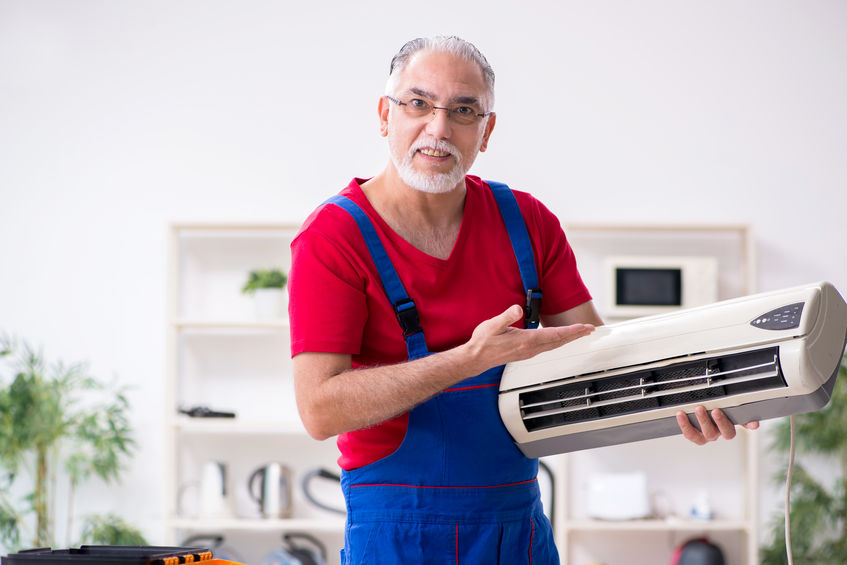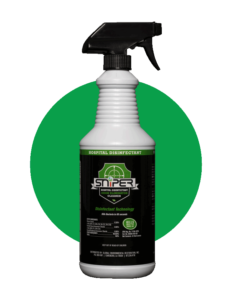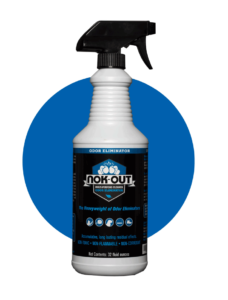SNiPER: The Perfect Disinfectant for HVAC Systems

SNiPER Has Been Approved by the EPA to Disinfect HVAC systems
SNiPER is now approved for use as a disinfectant for HVAC systems including the ductwork. This Product is designed to be used as one component of a comprehensive HVAC and duct maintenance program. The purpose of such a program is to assure that the HVAC system and ducts function in the manner they were designed to, remain free from microbial growth and other contamination, and continue in that condition. This Product should only be used in those cases where visible microbial growth has been detected in the system and then only after removing that growth and identifying and correcting the conditions that led to that growth. It may also be used to inhibit growth on surfaces that normally become wet during operation of the system. These normally include (but are not limited to) evaporator coils, uninsulated piping, condensate drain pans, drain lines, silicon caulks, mist eliminators and cabinet housing components subject to wetting by mist or carryover of water.
When the below directions are followed properly, there will not be significant concentrations of SNiPER released to the spaces served by a system being treated. There is no need to have occupants leave the building during application.
HVAC Directions for Use
The following instructions are directly from the extended label that is on the jug in font size 5, which is difficult to read being so small, so we are republishing the instructions from the label here, for your convenience.
FOR ANTIMICRIOBIAL CONTROL IN HVAC SYSTEMS AND AIR DUCTS (INCLUDING ODOR CAUSING BACTERIA). IT IS A VIOLATION OF FEDERAL LAW TO USE THIS PRODUCT IN A MANNER INCONSISTENT WITH ITS LABELING.
THE PERSON APPLYING THIS PRODUCT IS RESPONSIBLE FOR FOLLOWING THESE DIRECTIONS UNDER BOTH STATE AND FEDERAL LAWS.
If you need help in understanding any part of these instructions or have additional questions after reading these instructions, DO NOT APPLY THIS PRODUCT until you have received the answers for all of your questions.
Inspection
Prior to inspecting, cleaning, treating, repairing or otherwise working on the HVAC or duct section, the HVAC system should be turned off or the section under repair physically isolated from sections in active use. Prior to any application of SNiPER the system must be inspected for cleanliness and mechanical condition. When initiating any measures to repair, clean or treat HVAC system components or air ducts, industry standards from the American Society of Heating and Refrigeration Engineers (ASHRAE), National Air Duct Cleaners Association (NADCA), Indoor Air Quality Association (IAQA) and other organizations must be followed. HVAC systems should be routinely inspected for cleanliness by visual means. The NADCA Standard, Assessment, Cleaning and Restoration of HVAC Systems (ACR 2002 or the latest revision), provides minimum recommended inspection frequency schedules for ducts and other system components. More information on NADCA standards can be obtained from the NADCA web site at www.nadca.com.
Cleanliness Inspection
According to NADCA Standards, HVAC system cleaning must be performed when any of the following conditions are found in the cleanliness inspection. If any of these deficiencies are found during inspection, cleaning in accordance with industry standards must be performed prior to the application of SNiPER. At a minimum, these standards require removing all loose soil and debris with a HEPA filter equipped vacuum cleaner and complete cleaning of soil from all heat exchange surfaces using a special cleaner formulated so as to clean such soils effectively yet not damage heat exchange components or release unpleasant or potentially damaging fumes.
Contamination
HVAC systems should be operated in a clean condition. If significant accumulations of contaminants or debris are visually observed within the HVAC system, then cleaning is necessary. Likewise, if evidence of microbial growth is visually observed or confirmed by analytical methods, then cleaning is required. If the HVAC system discharges visible particulate into the occupied space, or a significant contribution of airborne particles from the HVAC system into the indoor ambient air is confirmed, then cleaning is necessary. Heat exchange coils, cooling coils, air flow control devices, filtration devices, and air-handling equipment determined to have restrictions, blockages, or contamination deposits that may cause system performance inefficiencies, air flow degradation, or that may significantly affect the design intent of the HVAC system, require cleaning. Drain pans must be free from slime and sludge or other contamination. Badly rusted or corroded drain pans must either be repaired or replaced.
Fans and Fan Housings: Must be free from accumulations of microbial growth and particulate matter.
Filters
Must be in good condition and cleaned or replaced as needed to avoid exceeding the allowable pressure drop for the equipment. If you need help in understanding existing industry standards, consult a qualified professional or contact Customer Service at 1-877-236-4710 for guidance and further direction or consult the information at www.epa.qov (search on “HVAC Systems” or “air ducts”). In addition, the following association and society Internet sites should be consulted for information on standards and guidelines they have developed: ACCA – www.acca.org ASHRAE – www.ashrae.org NADCA – www.nadca.com NAIMA – www.naima.org, SMACNA – www.smacna.org.
Mechanical Inspection
SNiPER must be used only on HVAC system components and air ducts in sound mechanical condition as defined in 2.2.1 and 2.2.2 (below). The HVAC system components must be designed and installed in conformance with industry standards and guidelines. Prior to using the Product, inspect the HVAC system and ducts and assure that they are in sound mechanical condition. The following general guidelines, supplemented by industry standards from SMACNA, NAIMA, ASHRAE, ACCA and other organizations, must be followed:
Air Leaks and Mechanical Defects
The equipment housing, cabinets and ducts must be free from air leaks and other mechanical defects. Air leaks will promote condensation of water that causes microbial growth and will lead to failure of SNiPER to protect the system adequately.
Design and Installation
ASHRAE, SMACNA, NAIMA and other industry organizations have established guidelines and standards for the design and installation of HVAC and duct systems. You should determine that the system components you wish to treat conform to industry practice. If you are not knowledgeable of industry guidelines and standards, consult a qualified professional or contact Customer Service at 1-877-236-4710 for assistance. In some situations, the inspection may reveal that a component of the HVAC or duct system is badly damaged or in such poor operating condition that it cannot be corrected through cleaning and/or minor repair. In these situations, the system should be replaced or rebuilt in conformity to the applicable industry standards prior to using SNiPER. Some (but not all) of the conditions that would indicate the need for major repairs or replacement of the system include: Improper size of system or component: The system and all components must be sized to achieve correct airflow and be of the proper capacity for the load. When air-handling equipment is changed or new inlets or outlets added, the size of all components in the system should be recalculated and replacements made as needed.
Physical Damage
Crushed or physically damaged equipment may leak or fail to perform as designed. Deformed air ducts will restrict airflow and may leak (especially at joint areas). Damaged equipment must be repaired or replaced or if there is extensive damage, the entire system should be replaced. Badly corroded metal components: Including duct sections, housings and cabinets, coil assemblies, drain pans, fans and their housings and heat exchange surfaces.
Loose, Damaged, Friable or Missing Insulation
Insulation is important in preventing moisture condensation and subsequent growth of bacteria and other organisms. If insulation (either interior or exterior) is damaged, missing or not properly fastened it must be repaired or replaced or the associated duct sections replaced. Air handler, mixing, and VAV box housings are also normally insulated and this insulation should be checked for damage in a like manner. Removed components that are contaminated with bacteria and other microbial growth may spread contamination while being removed from the building. To prevent this, smaller items should be placed in plastic bags that should then be sealed before being removed. Larger items that cannot be safely packaged should be treated before being moved through occupied spaces. An appropriately labeled disinfectant can be used during treatment. Care must be used during treatment to assure that fumes from the agent being used are not released into occupied spaces. Products used should be used according to their label directions. Please contact Customer Service at 1-877-236-4710 for guidance on the appropriate disinfectant to use for treatment.
General Directions for Usage
SNiPER effectively controls by inhibiting growth of odor causing bacteria, fungi, and other odor, stain or damage causing organisms in HVAC system components and air ducts in residential, commercial, institutional, and industrial buildings. SNiPER also eliminates odors associated with bacteria, smoke, animals, cooking, spoilage, musty and other odors and removes odor-causing organisms when used as part of such a comprehensive preventative maintenance program in HVAC systems and air ducts. SNiPER is a bacteriostat, fungistat, and deodorizer for use in residential, commercial and industrial settings. It will not stain or bleach materials or fabrics and will not harm or damage HVAC system components.
SNiPER is Formulated for Use in All Kinds
of HVAC Components and Air Ducts Including:
- Furnaces,
- Air Handlers,
- Packaged units including Rooftops and Packaged Terminal Air Conditioner (PTAC) units,
- Fan coil units,
- Air distribution components such as air handlers, mixing boxes, transfer boxes, transitions, and turning vanes, dampers, fans and fan housings, and associated components
- Condensate drain pans,
- Unlined sheet metal ducts,
- Air supply and return ducts and plenums fabricated with plywood, OSB or other wood like material
- Flexible air ducts fabricated of metal or plastic,
- Humidifiers,
- Dehumidifiers; both Desiccant and Refrigerated,
- Registers, Grills and other air intake and discharge devices
Follow the directions below for the specific type of duct or component being treated. It is vital that the following directions be carefully read and understood prior to using the Product. If you have any questions, need further information, require clarification, or do not understand any of the directions, call Customer Service at 1-877-236-4710 prior to use.
HVAC Application Instructions
Wet the surfaces with the spray, giving special attention to cracks and crevices. [Product] will not stain any materials not stained by water] we suggest testing for compatibility on surface of concern first. Allow ten to twenty minutes for drying. No rinsing or wiping is required. Following the elapsed drying time it is best practice to purge the system, by increasing the negative pressure through the outdoor exhaust or negative air machine or by turning on the vacuum used to preclean the HVAC system, while removing the duct openings seals. This will minimize the release of scent into the spaces served by the system.
Application Equipment and Devices: Refer to the precautionary statements for the Personal Protective Clothing and other special instructions that must be followed.
Spray Applicators
Spray application is preferred on large surfaces that are easily accessible (such asplenums, coil assemblies, the interior of cabinets, housings with removable access panels, and in long runs of large diameter ducts). The spray equipment chosen should provide a consistent fine (1-300 micron) particle size and uniform spray pattern. Powered medium pressure sprayers are preferred. However, airless sprayers are suitable. Where airless sprayers are used, the most satisfactory spray pattern will be achieved using a 0.01 1″ spray tip. For other brands and options contact Customer Service at 1-877-551-1927. Pump up garden type sprayers can be used but care must be taken to maintain maximum pressure by pumping frequently and the spray nozzle must be adjusted for the finest spray pattern possible. During application achieve complete uniform coverage. Avoid excessive wetting and do not allow the spray to run or pool. Automated Atomizing or Spray System: There are a number of automated spraying systems on the market including those that are carried by a “robot” through air ducts. These may provide an excellent option for application of SNiPER in parts of air ducts that are difficult to access if they produce the correct spray pattern and application quantity. These devices must be visually monitored using video or other means while applying spray so proper application rate will be maintained. Please contact Customer Service at 1-877-236-4710 regarding a specific device should you have questions. Brush, Mop or Wipe Application: Brush, Mop or Wipe Application may be specified by some facility maintenance or remediation plans. These techniques are generally more labor intensive than other methods and are normally used only when specifications require. These methods are suitable only for smooth uniform surfaces. Do not use on porous or non-uniform surfaces. If in doubt about a given surface, contact Customer Service at 1-877-236-4710 before proceeding. When using brush or mop application, tools and materials used should be reserved only for application of SNiPER, kept clean and protected between uses and replaced when worn or visibly soiled. Natural fiber brushes are preferred although any quality brush is acceptable. Mops should be of the types that leave minimal lint behind. Micro-fiber or other non-linting cloths are preferable. Where other types of cloths are used, they must be soft enough that they absorb a sufficient quantity of liquid to provide uniform application. During Brush, Mop or Wipe Application, the applicator must have access to the surfaces being treated. Usually this will require entering the component or air ducts. In such cases, application must start from the point most distant from the point of entry. The applicator will then work from that point back to the entry point covering a 3-foot length of duct at a time. Apply to the top of the area to be treated first, followed by the sides then the floor. Overlap applications to assure complete coverage. Cover completely while avoiding runs or pooling. Application Techniques: SNiPER must be applied evenly to surfaces that are being treated. Even and uniform application is essential for satisfactory results. The procedures, equipment and techniques described below have been tested and provide the desired results. Other procedures, equipment or techniques may also achieve satisfactory results but should not be used without discussing the specific situation and equipment with a Customer Service Representative who can be reached toll free at 1-877-236-4710.
Application from Exterior of the HVAC System or Air Duct:
SNiPER may be sprayed into existing access openings where these provide adequate access. Normally these consist of removable panels or access doors. Completely cover all nonelectrical components until they are thoroughly and uniformly covered using hand or powered spray equipment. This is the technique of choice for large penthouse or built up air handlers and other components with access panels or doors. When applying to ductwork, spray into openings at a minimum of every 8 feet Existing supply openings can be used where they provide a clear view of the surfaces being sprayed so that uniform application can be achieved. However, additional penetrations will have to be made, as needed, so enough openings will be available to achieve total and uniform coverage. Spray application is not an acceptable technique where openings are greater than 8 feet apart, additional openings cannot be made and properly sealed, and/or the duct geometry does not allow for uniform coverage. In such cases, application from within the HVAC system is necessary (see 3.3.2 below).
Application from Within the HVAC System: When SNiPER cannot be sprayed into openings at intervals throughout the HVAC or duct system, you must gain entry into the system and spray the SNiPER onto interior surfaces until they are thoroughly and uniformly covered using hand or powered spray equipment. This is the most frequently used technique and is the technique of choice for air handlers, other components with access panels or doors and large diameter (generally 20″ x 20″ minimum) ducts where direct access can be gained to surfaces being treated. Some protection is provided for drain pans by excess PRODUCT that runs off of cooling coils when they are treated. Spraying SNiPER onto the surfaces of the pan or pouring into the drain pan until the bottom of the pan is uniformly wetted, can provide additional protection. Before treating the drain pan, check to determine that the drain line is clear and free running and that the drain pan is clean and free of loose corrosion. Replace badly deteriorated pans. Drain pans that do not drain completely and retain water may experience microbial growth even when treated. Level drain pans and otherwise adjust them so water completely drains from them. Fans and Fan Housings: Fans create air turbulence, which can lead to condensation of water that supports bacterial and other growth. As a result, fan blade and blower wheel surfaces as well as associated housings are especially prone to fouling from both microbial growth and soil accumulation. It may be necessary to partially or completely remove and disassemble these components so they may be properly cleaned prior to application of SNiPER. Complete cleaning must take place before attempting to treat these components.
Humidifiers and Dehumidifiers: Because of the amount of water present, humidifiers and dehumidifiers are often sites especially prone to microbial growth. They also attract and hold soil as growth related contamination builds up over time. This accumulated material must be thoroughly removed prior to treatment with SNiPER. For some units, cleaning may also signal the need to replace pads, belts, wheels or service other components. The manufacturer of the unit being maintained should be consulted on the proper maintenance and cleaning procedure. Rate of Application: The recommended rate of application for PRODUCT varies depending on the surface being treated. Users of this Product must carefully follow the rate of application instructions provided below: Bare Metal and Flexible Ducts: Apply until surface is evenly wet. Coverage 1,000 ft2 per gallon. Spray coverage 500 ft2 per gallon. If the above application rates result in surface runoff or liquid pooling on the bottom of the duct, lower the application rate until the surface is thoroughly and evenly wet without runoff or pooling. The exception to this is when treating coil assemblies. In this case, the spray should be applied generously until there is runoff into the drain pan so as to penetrate the coil assembly to the greatest possible depth.
Semi Porous Surfaces such as Concrete or Plaster: Apply until surface is evenly wet. Coverage 500 ft2 per gallon. Wipe not recommended. Spray coverage 250- ft2 per gallon. SNiPER must penetrate into surface crevices and irregularities or it will not be effective. Inspect and assure that penetration is satisfactory. It may be helpful to apply half of the quantity needed for full coverage spraying from side to side then repeat the application moving the spray from top to bottom. Frequency of Application: Normally, infrequent application (every 3 months for HVAC Systems and every 6 months to every two years for air ducts) will provide effective control. Some critical applications such as HVAC and duct systems serving critical health care spaces or clean rooms where it is essential to minimize the generation of particulate matter that may be released as a by Product of microbial growth may require more frequent treatment. Do not apply more often than monthly and then only if there is evidence of re-growth. This Product must only be used in those cases where visible microbial growth has been detected in the system and then only after removing that growth and identifying and correcting the conditions that led to that growth. Prior to reapplication in such cases, investigate to determine the cause of re-growth and correct that problem prior to re-application.
Before embarking on a program of frequent application (more frequent than every three months) contact Customer Service at 1-877-551-1927 to discuss the specific application and situation. Also make sure the reoccurrence of microbial growth does not have another cause such as persistently high humidity, standing water or hidden leaks. Prior to reapplication, the interior of the ducts and other surfaces must be inspected and found to be free of accumulated soil. If soil or growth is found, the cause should be determined and corrected and then the ducts cleaned in accordance with accepted industry practice. If microbial growth persists in air ducts following application re-inspect for duct leaks, carryover of water from cooling coils or humidifiers and other sources of moisture promoting growth. Eliminate such sources of moisture before retreating.
Returning the System to Operation following Application: Equipment being treated and the fans and blowers in the section of duct being treated must be turned off during application of SNiPER. If the system cannot be shut down, the section of the system being treated must be isolated until treatment is complete. This will prevent the spray from being blown away from the surface that is being treated. Do not attempt to use the system fan or blower to carry SNiPER to the surfaces within system. Such a practice will not result in uniform application of the Product to the surfaces being treated and will lead to ineffective control. Do not attempt this. The system can be returned to full operation as soon as treatment is completed or at any time following completion of treatment. SNiPER will dry on surfaces within 15 minutes following application. Extended drying time does not have an impact on effectiveness of treatment. SNiPER should not be rinsed off following application so it will continue to inhibit the growth of microorganisms on treated surfaces.
When the above directions are followed properly, there will not be significant concentrations of Product released to the spaces served by a system being treated. There is no need to have occupants leave the building during application.
Try Some Today!
Imagine having one cleaner and one deodorizer for all your cleaning needs that is safe, green, and powerful. Now you can!
Get ready to throw out all your toxic products.


